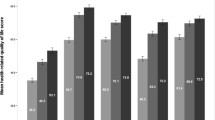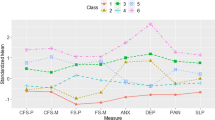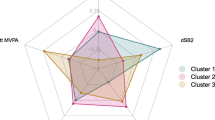Abstract
Purpose
The symptoms of multiple sclerosis (MS) often cause physical and mental dysfunction, which interferes with a person’s ability to participate in life’s roles. Identification of the strength of the contributors to participation would help prioritize intervention approaches for its improvement. The objective of this study was to estimate the extent to which pain and other MS-related symptoms, physical function, psychological variables, and individual characteristics predict participation in people with MS.
Methods
This was a cross-sectional study. Study sample was a center-stratified random sample of 188 persons with MS. Subjects completed a battery of self-report and performance-based measures that assessed participation and domains affecting participation. To model the relationships among variables, a conceptual framework based on the Wilson and Cleary model was tested. Structural equation modeling aimed at identification of the predictors of participation within the hypothesized theoretical model.
Results
Fatigue (β = 0.63, p < 0.0001), physical function (β = 0.37, p < 0.0001), and psychological variables (β = 0.15, p = 0.04) were found to be as significant direct predictors of participation. Pain (β = 0.4, p < 0.0001) and age (β = 0.12, p < 0.0001) were significant indirect predictors through fatigue and physical function, respectively. Together these effects explained 88 % of the variance of participation, 35 % of the variance in psychological variables, and 29 % of the variance in physical function.
Conclusion
Fatigue, physical function, pain, and psychological variables were most important contributors for participation in persons with MS.


Similar content being viewed by others
References
Noseworthy, J. H., Lucchinetti, C., Rodriguez, M., & Weinshenker, B. G. (2000). Multiple sclerosis. New England Journal of Medicine, 343, 938–952.
O’Connor, P. (2009). Key issues in the diagnosis and treatment of multiple sclerosis: An overview. Neurology, 59, S1–S33.
Richards, R. G., Sampson, F. C., Beard, S. M., & Tappenden, P. (2002). A review of the natural history and epidemiology of multiple sclerosis: Implications for resource allocation and health economic models. Health Technology Assessment, 6(10), 1–73.
Devins, G. M., Dion, R., Pelletier, L. G., Shapiro, C. M., Abbey, S., & Raiz, L. R. (2001). Structure of lifestyle disruptions in chronic disease, a confirmatory factor analysis of the Illness Intrusiveness Ratings Scale. Medical Care, 39(10), 1097–1104.
Neubeck, L., Freedman, S. B., Clark, A. M., Briffa, T., Bauman, A., & Redfern, J. (2012). Participating in cardiac rehabilitation, a systematic review and meta-synthesis of qualitative data. European Journal of Preventive Cardiology, 19(3), 494–503.
Barclay-Goddard, R., Ripat, J., & Mayo, N. (2012). Developing a model of participation post-stroke, a mixed-methods approach. Quality of Life Research, 21, 417–426.
Mayo, N. E., Wood-Dauphinee, S., Cote, R., Durcan, L., & Carlton, J. (2002). Activity, participation, and quality of life six months post-stroke. Archives of Physical Medicine and Rehabilitation, 83, 1035–1042.
World Health Organization. (2001). International classification of functioning, disability and health (2nd revision ed.). http://www3.who.int/icf/icftemplate.cfm. Geneva.
Salter, K., Jutai, J. W., Teasell, R., Foley, N. C., Bitensky, J., & Bayley, M. (2005). Issues for selection of outcome measures in stroke rehabilitation, ICF participation. Disability and Rehabilitation, 27(9), 507–528.
Johnston, M. V., & Miklos, C. S. (2002). Activity-related quality of life in rehabilitation and traumatic brain injury. Archives of Physical Medicine and Rehabilitation, 83(Suppl 2), S26–S38.
Whiteneck, G. G., Charliefue, S. W., & Gerhart, K. A. (1992). Quantifying handicap, a new measure of long-term rehabilitation outcomes. Archives of Physical Medicine and Rehabilitation, 73, 519–526.
Phillips, L., & Stuifbergen, A. (2009). Structural equation modeling of disability in women with fibromyalgia or multiple sclerosis. Western Journal of Nursing Research, 31, 89–109.
Yorkston, K., Johnson, K., & Klasner, E. (2005). Taking part in life, enhancing participation in multiple sclerosis. Physical Medicine & Rehabilitation Clinics of North America, 16, 583–594.
Shahrbanian, S., Auais, M., Duquette, P., Andersen, K., & Mayo, N. E. (2013). Does pain in individuals with multiple sclerosis affect employment? A systematic review and meta-analysis. Pain Research & Management, 18(5), e94–e100.
Ehde, D. M., Osborne, T. L., & Jensen, M. P. (2005). Chronic pain in persons with multiple sclerosis. Physical Medicine & Rehabilitation Clinics of North America, 16, 503–512.
Archibald, C. J., McGrath, P. J., & Ritvo, P. G. (1994). Pain prevalence, severity and impact in a clinic sample of multiple sclerosis patients. Pain, 58, 89–93.
Hadjimichael, O., Kerns, R. D., Rizzo, M. A., Cutter, G., & Vollmer, T. (2007). Persistent pain and uncomfortable sensations in persons with multiple sclerosis. Pain, 127, 35–41.
Warnell, P. (1991). The pain experience of a multiple sclerosis population, a descriptive study. Axon, 13, 26–28.
Kerns, R., Kassirer, M., & Otis, J. (2002). Pain in multiple sclerosis, a biopsychosocial perspective. Journal of Rehabilitation Research and Development, 39, 225–232.
Wilson, I. B., & Cleary, P. D. (1995). Linking clinical variables with health-related quality of life. A conceptual model of patient outcomes. JAMA, 273(1), 59–65.
Kurtzke, J. F. (1983). Rating neurologic impairment in multiple sclerosis, an expanded disability status scale (EDSS). Neurology, 33(11), 1444–1452.
Ng, P., Finch, L., Hum, S., & Mayo, N. E. (2013). The path to work capacity in people with multiple sclerosis. Dissertation, McGill University.
Jensen, M. P., Turner, J. A., & Romano, J. M. (1999). Comparative reliability and validity of chronic pain intensity measures. Pain, 83, 157–162.
Margolis, R. B., Tait, R. C., & Krause, S. J. (1986). A rating system for use with patient pain drawings. Pain, 24, 57–65.
Hays, R. D., Sherbourne, C. D., & Mazel, R. M. (1993). The RAND 36-item health survey 1.0. Health Economics, 2(3), 217–227.
Ware, J. E, Jr. (1987). Standards for validating health measures: Definition and content. Journal of Chronic Diseases, 40(6), 473–480.
Bjelland, I., Dahl, A. A., Haug, T. T., & Neckelmann, D. (2002). The validity of the hospital anxiety and depression scale, an updated literature review. Journal of Psychosomatic Research, 52, 69–77.
Illfeld, F. W. (1976). Further validation of a psychiatric symptom index in a normal population. Psychological Reports, 39, 1215–1228.
Sullivan, J. L., Edgley, K., & Dehoux, E. (1990). A survey of multiple sclerosis. Part 1: Perceived cognitive problems and compensatory strategy use. Canadian Journal of Rehabilitation, 4(2), 99–105.
Gronwall, D. M. (1977). Paced auditory serial-addition task, a measure of recovery from concussion. Perceptual and Motor Skills, 44(2), 367–373.
Cella, D. F., Dineen, K., Arnason, B., Reder, A., Webster, K. A., & Karabatsos, G. (1996). Validation of the functional assessment of multiple sclerosis quality of life instrument. Neurology, 47, 129–139.
Ritvo, P., Fischer, J. S., Miller, D., Andrews, H., Paty, D., & LaRocca, N. G. (1997). Multiple sclerosis quality of life, A user’s manual. Denver: National Multiple Sclerosis Society.
Weinshenker, B. G., Bass, B., Rice, G. P. A., Noseworthy, J., Carriere, W., Baskerville, J., et al. (1989). The natural history of multiple sclerosis: A geographically based study. Brain, 112, 133–146.
Becker, H., Stuifbergen, A. K., & Sands, D. (1991). Development of a scale to measure barriers to health promotion activities among persons with disabilities. American Journal of Health Promotion, 5(6), 44–454.
Poissant, L., Mayo, N. E., Wood-Dauphinee, S., & Clarke, A. E. (2003). The development and preliminary validation of a preference-based stroke index (PBSI). Health and Quality of Life Outcomes, 1, 15–43.
Devins, G. M. (2010). Using the illness intrusiveness ratings scale to understand health-related quality of life in chronic disease. Journal of Psychosomatic Research, 68(6), 591–602.
Goldman, M. D., Marrie, R. A., & Cohen, J. A. (2008). Evaluation of the six-minute walk in multiple sclerosis subjects and healthy controls. Multiple Sclerosis Journal, 14(3), 383–390.
Tyson, S., & Connell, L. (2009). The psychometric properties and clinical utility of measures of walking and mobility in neurological conditions, a systematic review. Clinical Rehabilitation, 23(11), 1018–1033.
Tesio, L., Perucca, L., Franchignoni, F. P., & Battaglia, M. A. (1997). A short measure of balance in multiple sclerosis, validation through Rasch analysis. Functional Neurology, 12(5), 255–265.
Bohannon, R. W., & Smith, M. B. (1987). Interrater reliability of a modified Ashworth scale of muscle spasticity. Physical Therapy, 67(2), 206–207.
Health, C. S. E. P., Appraisal, F. P. H.-R., & Strategy, C. (2004). The Canadian physical activity, fitness and lifestyle approach (3rd ed.). Ontario: Canadian Society for Exercise Physiology.
Markovic, G., Dizdar, D., Jukic, I., & Cardinale, M. (2004). Reliability and factorial validity of squat and countermovement jump tests. Journal of Strength and Conditioning Research, 18(3), 551–555.
Mathiowetz, V., Weber, K., Volland, G., & Kashman, N. (1984). Reliability and validity of grip and pinch strength evaluations. Journal of Hand Surgery. American Volume, 9(2), 222–226.
Cano, S., Barrett, L., Zajicek, J., & Hobart, J. (2011). Beyond the reach of traditional analyses, using Rasch to evaluate the dash in people with multiple sclerosis. Multiple Sclerosis Journal, 17, 214–222.
Kline, R. B. (2011). Principles and practice of structural equation modeling (3rd ed.). New York: Guilford.
Hu, L., & Bentler, P. M. (1999). Cutoff criteria for fit indexes in covariance structure analysis, conventional criteria versus new alternatives. Structural Equation Modeling, 6, 1–55.
MacCallum, R. C., Browne, M. W., & Sugawara, H. M. (1996). Power analysis and determination of sample size for covariance structure modeling. Psychological Methods, 1, 130–149.
Muthén, L. K., & Muthén, B. O. (1998–2012). Mplus User’s Guide (7th ed.). Los Angeles, CA: Muthén & Muthén.
SAS 9.2 (computer program). (2008). Version 9.2. Cary, NC, SAS Institute Inc.
Kempen, J. C. E., de Groot, V., Knol, D. L., Lankhorst, G. J., & Beckerman, H. (2012). Self-reported fatigue and energy cost during walking are not related in patients with multiple sclerosis. Archives of Physical Medicine and Rehabilitation, 93(5), 889–895.
Khan, F., Amatya, B., & Galea, M. (2014). Management of fatigue in persons with multiple sclerosis. Frontiers in Neurology, 15(5), 177.
Lapierre, Y., & Hum, S. (2007). Treating fatigue. The International MS Journal, 14, 64–71.
Asano, M., & Finlayson, M. L. (2014). Meta-analysis of three different types of fatigue management interventions for people with multiple sclerosis: Exercise, education, and medication. Multiple Sclerosis International,. doi:10.1155/2014/798285. (Epub 2014 May 14).
Asano, M., Berg, E., Johnson, K., Turpin, M., & Finlayson, M. L. (2014). A scoping review of rehabilitation interventions that reduce fatigue among adults with multiple sclerosis. Disability and Rehabilitation, 37(9), 729–738.
Skerrett, T. N., & Moss-Morris, R. (2006). Fatigue and social impairment in multiple sclerosis, the role of patients’ cognitive and behavioral responses to their symptoms. Journal of Psychosomatic Research, 61(5), 587–593.
Van Kessel, K., & Moss-Morris, R. (2006). Understanding multiple sclerosis fatigue, a synthesis of biological and psychological factors. Journal of Psychosomatic Research, 61(5), 583–585.
Motl, R. W., Snook, E. M., & Schapiro, R. T. (2008). Symptoms and physical activity behavior in individuals with multiple sclerosis. Research in Nursing & Health, 31, 466–475.
Shahrbanian, S., Duquette, P., Kuspinar, A., & Mayo, N. E. (2015). Consequences of symptom cluster in individuals with multiple sclerosis. Quality of Life Research Journal, 24(3), 617–629.
Lublin, F. D., & Reingold, S. C. (1996). Defining the clinical course of multiple sclerosis: results of an international survey. National multiple sclerosis society (USA) advisory committee on clinical trials of new agents in multiple sclerosis. Neurology, 46(4), 907–911.
Mayo, N. E., Scott, S. C., & Bayley, M. (2015). Modeling health-related quality of life in people recovering from stroke. Quality of Life Research, 24(1), 41–53.
Multiple Sclerosis Society of Canada. (2009). www.mssociety.ca. Canada, MS Society of Canada.
Mayo, N. (2008). Setting the agenda for multiple sclerosis rehabilitation research. Multiple Sclerosis Journal, 14(9), 1154–1156.
Leary, S., & Thompson, A. (2000). Current management of multiple sclerosis. International Journal of Clinical Practice, 54, 161–169.
Acknowledgments
Shahrbanian was a recipient of the Canadian Institutes of Health Research Award (Grant No. 218665). Authors also acknowledge the contribution of Ayse Kuspinar, Shang Yuan Teng, and Elaine Roger, who recruited patients from MNH, CNRS, and CHUM, respectively.
Author information
Authors and Affiliations
Corresponding author
Ethics declarations
Conflict of interest
The authors declare that there is no conflict of interest.
Ethical standard
Study protocol and procedures were approved by the ethics committee of each participating hospital, and informed consent was obtained and signed by all subjects on the day of testing.
Appendix
Rights and permissions
About this article
Cite this article
Shahrbanian, S., Duquette, P., Ahmed, S. et al. Pain acts through fatigue to affect participation in individuals with multiple sclerosis. Qual Life Res 25, 477–491 (2016). https://doi.org/10.1007/s11136-015-1098-0
Accepted:
Published:
Issue Date:
DOI: https://doi.org/10.1007/s11136-015-1098-0




